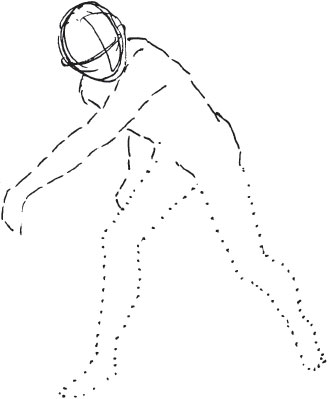29 Dividing the Body Into Units

One way to keep continuity of parts in your sketches is to divide the body into two or three units. While sketching in unit #1 see unit #2 clearly in your peripheral vision and even, in a lesser degree the third unit. Then while sketching unit #2, keep the third unit clearly in mind plus the unit you have just sketched in. The idea is that the whole pose must be kept constantly in mind — no going off and drawing a head or an arm as something separate, but rather as parts of a whole. The relationship of the shoulders, elbows, hands, etc., and especially the foot on which the weight of the body is on, must be “mapped” out or planned ahead so that the essence of the pose is not lost — or in regard to the weight, the whole drawing be off balance. Let the mind and the eyes constantly scan the pose so as not to lose sight of the first impression — which was the fresh, vivid view of the whole gesture before you get involved in drawing the parts.
All too often in sketching, while not seeing the whole figure (the figure as a whole, that is), it is possible to end up with a delightful drawing, but which is at variance with the pose or gesture. It is fine when doodling to start out with nothing in mind — somewhere on the paper — and end up with a presentable drawing with a gesture of its own (but not yours). But when striving for a predetermined gesture, a measure of discipline is necessary. You not only must capture what is needed but perhaps even push it a little further. In cartooning (animation) we often push the gestures so far they become a caricature. With this kind of discipline under your belt even your doodles will be more meaningful.
You might liken drawing to playing a musical instrument — especially one like a horn or a stringed instrument where you have to manipulate your highly disciplined lips or fingers to produce a tone. The music (in drawing the pose) must be reproduced perfectly or something is lost (most likely the audience). Jazz improvisation is more like doodling except that it is produced within a certain structure, rhythm, harmony, key, style, etc., so even here, there is discipline. Any of you who play a musical instrument will know that you have to use your peripheral vision to look ahead a measure or two to keep any kind of continuity going. The rhythm would falter musically if the notes were read one at a time, likewise in drawing, the pose must be captured with a continuity of form — a looking ahead to tie all the parts into a rhythmical and faithful express of the pose.
